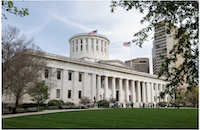

(The Center Square) – A new report from Ohio’s Legislative Service Commission says that “decades of research failed to find significant impacts on employment from the construction of new sports stadiums” as the state considers $600 million in taxpayer funds in its budget for the Cleveland Browns for a new $2.4 billion stadium in Brook Park.
The service commission’s report cites extensive studies from economists such as Kennesaw State's J.C. Bradbury that show the lack of positive economic impact from taxpayer money spent on stadiums.
“The academic literature on publicly funded sports stadiums is vast, covering many decades, sports, states, and municipalities,” the report says. “The overwhelming conclusion from this body of research is that there are little to no tangible impacts of sports teams and facilities on local economic activity
“A second conclusion is that the level of government subsidies given for the construction of facilities far exceeds any observed economic benefits when they do exist. RCLC’s executive summary contains claims that contradict these widely known research findings, but LBO cannot verify RCLC’s claims because the source material and methodology were not documented in full detail.”
Senate Democratic Leader Nickie Antonio, D-Lakewood, represents an area that includes both Brook Park and parts of Cleveland. Antonio requested the independent service commission report and wrote Attorney General Dave Yost asking if the legislation funding the $600 million in the proposed Ohio budget was constitutional.
Antonio's letter to Yost cited Yost's op-ed stating "billionaire owners would just keep coming" if $600 million was approved for a new Browns stadium.
“The proposed funding plan for the new Browns stadium raises serious legal and financial concerns,” Antonio said in a statement. “The Haslams’ projections are overly optimistic at best, and even their own consultants admit the analysis isn’t intended to justify financing. Let’s be clear: most of the so-called ‘new jobs’ are simply moving jobs away from Cleveland – stadiums like this do not deliver the economic windfalls they promise. We should not move forward until we know the courts, the numbers, and the public are on board.”
The report said that claims there will be 1.5 million new visitors at a new stadium were “overly optimistic” and that there isn’t evidence that there will be cost savings at a new stadium to offset losses at the current stadium in Cleveland.
While it isn’t common for politicians to release unfavorable reports on proposed stadium projects, Bradbury told The Center Square that the Browns stadium is somewhat “unique because you have different geographic entities impacted by the move.”
The Haslam Sports Group asked for $422 million in taxpayer funds from Brook Park, $178 million from Cuyahoga County and $600 million from the state of Ohio.
Bonds from the county and Brook Park are proposed to be paid off through a tax capture at the project site. The state bonds are also proposed to be special obligation bonds, not general bonds backed by the state.
Gov. Mike DeWine proposed to double the gambling tax from 20% to 40% to fund pro sports stadiums and youth sports. He said this would give the state another $130 million to $180 million a year for pro and minor league sports facilities. A new commission would decide which projects to fund, which would be capped at 40% of the total cost.
• • •• • •













